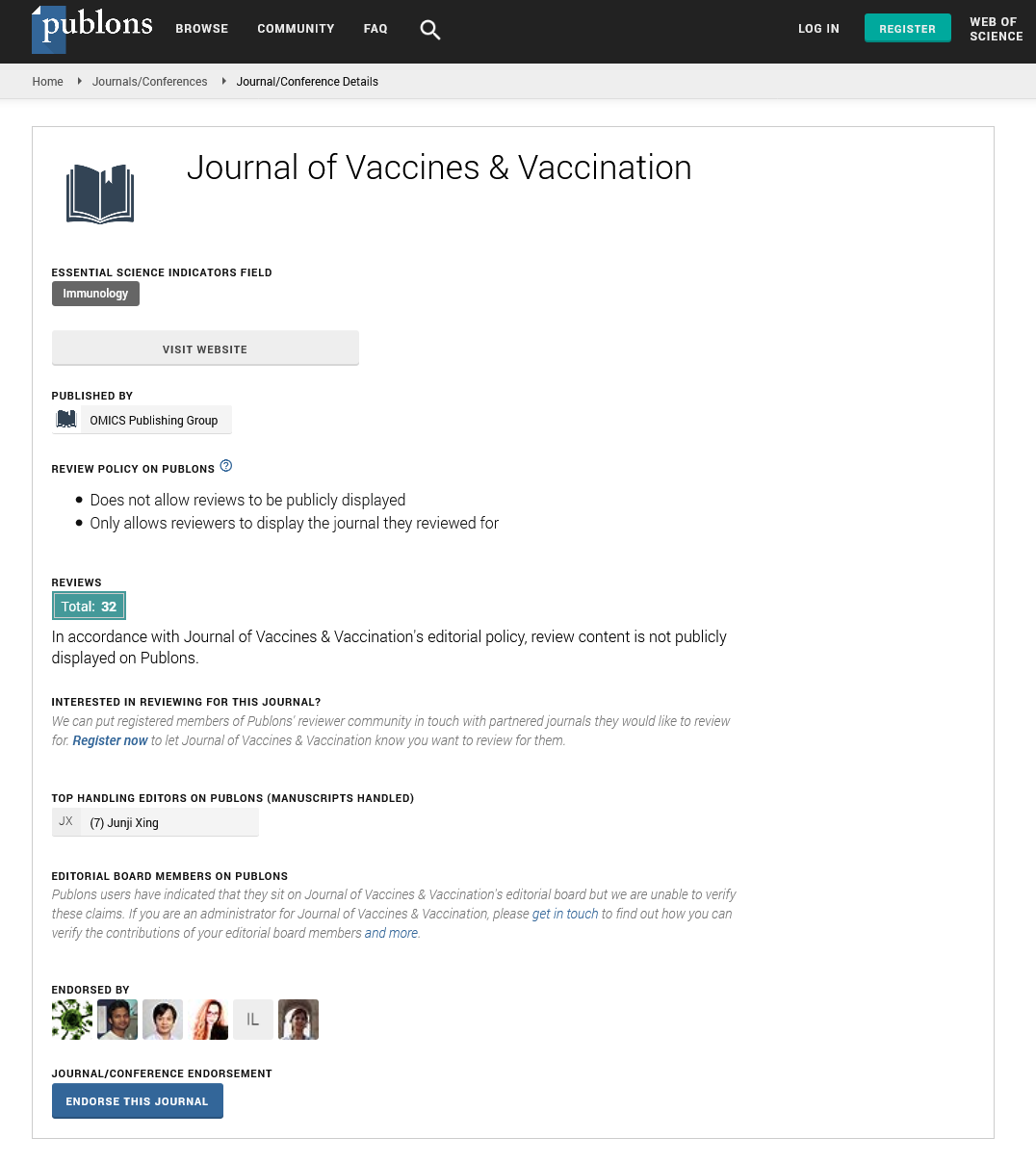Indexed In
- Academic Journals Database
- Open J Gate
- Genamics JournalSeek
- JournalTOCs
- China National Knowledge Infrastructure (CNKI)
- Scimago
- Ulrich's Periodicals Directory
- RefSeek
- Hamdard University
- EBSCO A-Z
- OCLC- WorldCat
- Publons
- MIAR
- University Grants Commission
- Geneva Foundation for Medical Education and Research
- Euro Pub
- Google Scholar
Useful Links
Share This Page
Open Access Journals
- Agri and Aquaculture
- Biochemistry
- Bioinformatics & Systems Biology
- Business & Management
- Chemistry
- Clinical Sciences
- Engineering
- Food & Nutrition
- General Science
- Genetics & Molecular Biology
- Immunology & Microbiology
- Medical Sciences
- Neuroscience & Psychology
- Nursing & Health Care
- Pharmaceutical Sciences
Opinion Article - (2024) Volume 0, Issue 0
Addressing Vaccine Hesitancy in the Digital Age: Strategies for Effective Communication
Shinji Yamada*Received: 29-Jul-2024, Manuscript No. . JVV-24-27432; Editor assigned: 31-Jul-2024, Pre QC No. JVV-24-27432 (PQ); Reviewed: 14-Aug-2024, QC No. JVV-24-27432; Revised: 21-Aug-2024, Manuscript No. JVV-24-27432 (R); Published: 28-Aug-2024, DOI: 10.35248/2157-7560.24.S28.001
Description
Vaccine hesitancy represents one of the most significant challenges to public health initiatives worldwide, with the World Health Organization identifying it as a top global health threat. The proliferation of misinformation through social media platforms has created unprecedented obstacles for healthcare providers and public health officials in promoting vaccine acceptance. Understanding and addressing these challenges requires a comprehensive, multifaceted approach that combines traditional public health strategies with innovative digital communication methods.
Social media algorithms often amplify controversial content, creating echo chambers that reinforce vaccine hesitancy through confirmation bias. These digital ecosystems can rapidly spread misinformation across global networks, making it increasingly difficult for public health authorities to maintain effective communication channels with hesitant populations. Healthcare providers must adapt their communication strategies to effectively counter misinformation while building trust with hesitant individuals, requiring a delicate balance between presenting scientific evidence and acknowledging legitimate concerns.
Research indicates that successful approaches often involve personalized communication, storytelling and community engagement. Healthcare providers should receive training in motivational interviewing techniques and cultural competency to address specific concerns within their communities effectively. Additionally, partnering with trusted community leaders and organizations can help close communication gaps and enhance message credibility. These partnerships prove particularly valuable in reaching underserved populations and communities with historical mistrust in healthcare systems.
Digital health literacy programs play a imporant role in helping people evaluate online health information critically. Public health organizations should invest in creating engaging, accessible content that explains vaccine science in plain language across various digital platforms. This content should be tailored to different educational levels and cultural contexts, ensuring maximum reach and impact. Interactive tools, infographics and short-form videos can effectively convey complex scientific information to diverse audiences.
Real-world examples demonstrate the effectiveness of proactive communication strategies. Some healthcare systems have successfully implemented social media monitoring tools to identify and address emerging concerns quickly. Others have developed targeted educational campaigns based on specific community needs and concerns, resulting in improved vaccine acceptance rates. These successful interventions often share common elements: transparency, cultural sensitivity and continuous community engagement.
Transparency about vaccine development, safety monitoring and adverse event reporting is essential for building public trust. Healthcare providers should be prepared to discuss both the benefits and potential risks of vaccination openly and honestly. This approach helps establish credibility and demonstrates respect for individual decision-making processes. Regular updates about safety surveillance and prompt acknowledgment of any emerging concerns can help maintain public confidence in vaccination programs.
Moving forward, research should focus on evaluating the effectiveness of different communication strategies across various demographic groups. This data can inform the development of more targeted and effective vaccine education programs. Studies should examine the impact of different message framing techniques, communication channels and messenger characteristics on vaccine acceptance rates.
Healthcare systems must also invest in training healthcare providers to effectively communicate with vaccine-hesitant patients. This training should include techniques for addressing common concerns, explaining scientific concepts in accessible language and maintaining productive discussions even when faced with strong opposition. Provider communication skills can significantly influence patient decision-making regarding vaccination.
The role of artificial intelligence and machine learning in addressing vaccine hesitancy deserves attention. These technologies can help identify patterns in vaccine hesitancy, predict areas of concern before they become widespread and optimize message delivery timing and content. However, their implementation must carefully consider privacy concerns and ethical implications.
Future strategies should emphasize building resilient communities capable of resisting misinformation while maintaining strong vaccination rates. This requires sustained investment in public health communication infrastructure, continuous evaluation and adaptation of messaging strategies and strong partnerships between healthcare providers, community organizations and digital platforms. Success in addressing vaccine hesitancy will require long-term commitment, flexibility and collaboration across multiple sectors of society.
Citation: Yamada S (2024). Addressing Vaccine Hesitancy in the Digital Age: Strategies for Effective Communication. J Vaccines Vaccin. S28:001.
Copyright: © 2024 Yamada S. This is an open access article distributed under the terms of the Creative Commons Attribution License, which permits unrestricted use, distribution and reproduction in any medium, provided the original author and source are credited.

